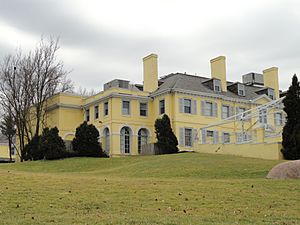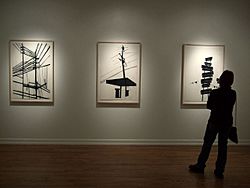Pittsburgh Center for the Arts facts for kids
 |
|
| Lua error in Module:Location_map at line 420: attempt to index field 'wikibase' (a nil value). | |
| Former name | Pittsburgh Arts and Crafts Center |
|---|---|
| Established | 1945 |
| Location | Pittsburgh |
| Designated: | 1971 |
The Pittsburgh Center for the Arts (PCA) is a special place in Pittsburgh, Pennsylvania. It's a non-profit organization that helps people learn about and enjoy art. The center offers art classes and shows modern art. It also helps artists in Western Pennsylvania by giving them tools and support.
The PCA is a place where everyone can create, see, and learn about visual arts. It was started in 1945. You can find it at 6300 Fifth Avenue in the Shadyside neighborhood. Some maps show it in the Point Breeze area.
A famous artist named Keith Haring had his very first art show here in 1978. This was before he moved to New York City. He became one of the most well-known artists of the late 20th century.
Contents
History of the Art Center
How the Center Started
The Pittsburgh Center for the Arts first opened its doors on March 17, 1945. It was called the "Arts and Craft Center" back then. Nearly 1000 people from Pittsburgh came to the opening night. The mayor, Cornelius D. Scully, was there. Mrs. Charles D. Marshall, who owned the building, gave the key to the city.
Ten different art groups came together to form the center:
- Pittsburgh Drama League (started 1913)
- Pennsylvania Guild of Craftsmen (started 1944)
- Weavers Guild of Pittsburgh (started 1940)
- Society of Sculptors (started 1934)
- Pittsburgh Civic Ballet (started 1941)
- Abstract Artists Group of Pittsburgh
- Musician's Club of Pittsburgh (started 1913)
- Associated Artists of Pittsburgh (started 1910)
- Contemporary Dance Group
- Authors’ Club (started 1918)
The first event after the grand opening was a music show. It was put on by the Musician's Club on March 25, 1945. Each of the ten groups had to hold five public events every year. The first Christmas Bazaar was held in November 1946. This event still happens today as the Holiday Sale.
The organization officially became a non-profit in July 1947. The first big meeting for all members was on January 12, 1948. New rules were read and accepted. The people chosen for the board and as officers did not get paid.
The center has always wanted to make Pittsburgh a better place through education. This idea has been important since the beginning. The first time classes were mentioned was in June 1947. A professor from the University of Pittsburgh asked to use the kitchen. He wanted to teach a jewelry class to about 40 students.
Besides teaching, the center has always promoted local art. In 1948, the first "Everyman's Art Show" was held. This show was open to amateur artists from the area. The first "Artist of the Year" show was in January 1949. It honored the painter Balcombe Greene.
In April 1954, the center started a weekly TV show on WQED-TV. It was called You, the Artists and was hosted by sculptor Everett Sturgeon. Later, from 1981 to 1989, the center had another show with WQED. It was called Lyceum (later Studio 13) and hosted by Mary Rawson. The center also shared news through newsletters and catalogs.
Changes and Growth
Over time, the center grew bigger and more complex. Volunteers found it hard to manage everything. In the late 1960s, the center needed more organized leadership. Danny Butts became the first full-time director. Later, Jerrold Rouby took over in 1970. More paid staff were hired, including an education director. The number of classes and students grew during Rouby's time.
In 1975, Audrey Bethel became the director. She helped make many important changes. Famous artists from around the country visited the center. The way the board of directors worked was updated. The center's name was also changed. Cheryl Towers became director in 1981. She hired Sande Deitch, a ceramic artist, as the full-time exhibitions director. Deitch became the center's director in 1987.
After the 1990s
The late 1990s were a time of big plans for the center. However, there were also money problems. In 2002, some staff members were let go. The exhibitions department was closed for a while. In August 2004, more staff were laid off. The center was in debt and had to close its doors for a few weeks.
The center has given special awards like "Artist of the Year" and "Emerging Artist of the Year." They also hold "Biennial exhibitions" for local artists. Past winners include Delanie Jenkins and Clayton Merrill.
In September 2004, Charlie Humphrey became the temporary director without pay. The center reopened quickly. They fixed problems with artists not being paid. They also improved relationships with groups that give money to support art.
In January 2006, the Pittsburgh Center for the Arts joined with Pittsburgh Filmmakers. This merger was approved by both groups. The rules of Pittsburgh Filmmakers became the rules for the new combined organization.
In Fall 2010, the combined Pittsburgh Filmmakers/Pittsburgh Center for the Arts talked about joining with the Pittsburgh Glass Center. But by May 2011, these talks did not work out. The Pittsburgh Glass Center decided not to merge.
Buildings and Campus
Over the years, many updates were made to the buildings. The Marshall building holds the art galleries. The Scaife building is where the art school is located. The last major update was to the Marshall building. It reopened on March 24, 1990. The mayor, Sophie Masloff, was there for the special event.
The center has a campus with four buildings. Three of these buildings are rented from the city for just $1.00 per year. These include two large mansions and a carriage house. The fourth building holds new kilns for pottery.
History of the PCA Buildings
In the early 1900s, many rich families in Pittsburgh built large homes. This area was called "Millionaires Row." Families like the Mellons and Fricks built impressive mansions.
In 1909, one of the biggest mansions was built. It was the 65-room Richard Beatty Mellon House. It sat on 11 acres of land. This land is now part of Mellon Park. Richard Beatty Mellon and his wife Jennie King Mellon lived there. Jennie King Mellon loved flowers. She had two very large flower gardens. These gardens still exist in Mellon Park today. Next to the mansion was a garage and carriage house. Servants lived on the second floor of the carriage house. This carriage house was given to the City. It is now the Phipps Garden Center. The big 65-room mansion was taken down in 1941.
Another mansion was built on the Mellon Estate in 1904. It was a Tudor revival style home. In 1927, it was given as a wedding gift to Richard Beatty's daughter, Sarah. She married Alan Magee Scaife. He was a director at Mellon National Bank. In February 1946, the Scaifes also gave their home to the City. This mansion is now the Scaife Building. It houses the Pittsburgh Center for the Arts School.
Next to the Mellon Estate was the home of Charles D. Marshall. He was the president of a big construction company. His mansion was finished in 1912. It was a grand building inspired by 17th-century English style. In 1943, Charles Marshall also gave his house at 6300 Fifth Avenue to the city. The city was responsible for keeping the outside of the building in good shape. This Marshall mansion became the Arts and Crafts Center of Pittsburgh in 1945. In 1980, its name was changed to the Pittsburgh Center for the Arts.


